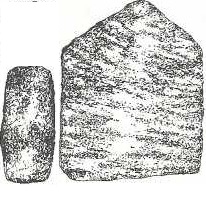Talk:Drsad and upala
From Hindupedia, the Hindu Encyclopedia
drṣad and upala
Vedic sacrifices are an ancient insti-tution. Out of the several materials used in the sacrifices for oblation into the duly consecrated fire, purodāśas or cakes made by baking pounded grains is also one. The two mill-stones used for pounding the grains are called dṛṣad and upala. Dṛṣad
is the lower stone, flat in shape whereas Upala is the upper cylindrical stone.

